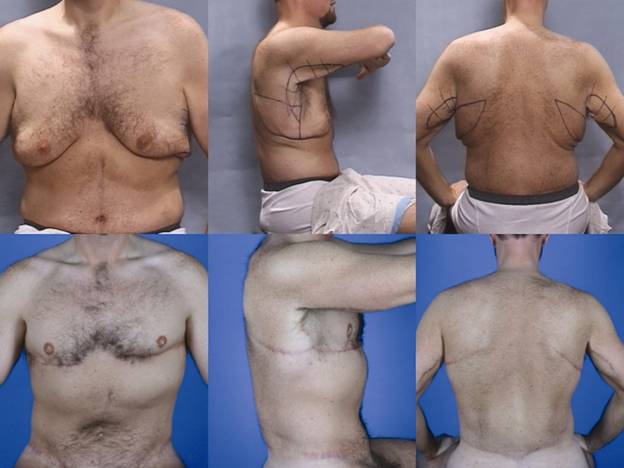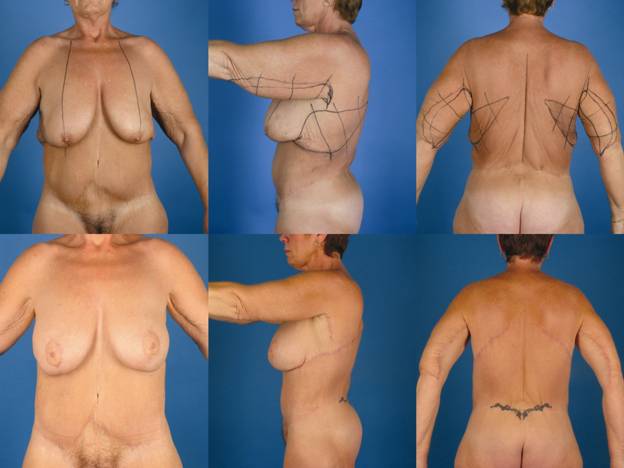Sunday, October 28, 2007 - 1:20 PM
12655
Upper Body Lifts in the Massive Weight Loss Patient
Purpose: Although some massive weight loss patients will present with isolated breast and upper arm problems, the majority of patients present with deformities that involve the entire thoracic unit. The purpose of this article is to define the typical deformities encountered in the thoracic region of the massive weight loss patient, describe three different “upper body lift” techniques that were utilized to treat various deformities, and to delineate the indications for performing upper body lifts.
Materials & Methods: A retrospective review of 15 patients who underwent upper body lifts was conducted, 10 females and 5 males. They were operated on between December 2003 and September 2006. Follow up ranged from 6 weeks to 3 years. A careful examination of their thoracic deformities was conducted to better understand how they occur and how they were treated. The indications for an “upper body lift” were determined for each patient.
Results: Analysis of the presenting patients' deformities revealed that they had both vertical and horizontal excess of their thoracic skin/fat envelope. The final appearance of their deformities was due to how this excess “hung off” of the “zones of adherence”, located anteriorly and posteriorly in the midline. Thus tissues that were situated at the greatest distance between the two zones of adherence, the lateral axillary line, descended the most. In other words, the lateral infra-mammary crease descended or “dropped out” laterally, and was associated with varying degrees of upper back excess. The concomitant breast deformities were variable and dependent on each patient's fat deposition pattern and sex. The operations designed to treat these deformities involved eliminating horizontal and vertical thoracic excess. They raised the lateral inframammary crease to an anatomically correct position, eliminated upper back rolls/excess, and treated the presenting breast deformity. Figure 1 shows the typical male pattern of upper body lifting which was utilized in all males. It eliminated horizontal and vertical excess and raised the lateral infra-mammary crease. Figure 2 shows the more common pattern for females, which was utilized in 8 patients and used whenever the patient had significant upper back excess. This pattern eliminated vertical excess and “filled out” the horizontal excess through the breast reconstruction. Figure 3 demonstrates the third and least common pattern, utilized in 2 females who presented with minimal upper back excess. In all but one male patient the upper body lift was combined with a brachioplasty that crossed the axilla onto the lateral chest wall. In the female group, 7 had mastopexy with augmentation; 6 salines and 1 silicone; 2 patients had mastopexy with autoaugmentation, and 1 had a reduction mammoplasty. All 5 male patients had gynecomastia reduction with a free nipple/areolar skin grafts. The indication for utilizing an “upper body lift” in each case was a descended or “dropped out” lateral inframammary crease. The most common complication was seroma which developed in 8 patients, with 6 in the arm, 1 in the back and 1 in the breast. They all resolved with aspiration and use of compression garments. Unilateral small fat necroses occurred in the two female patients who underwent autoaugmentation of their breasts requiring incision and drainage. Two patients required revisions, one for arm asymmetry and the other a revision mastopexy. One female patient had a dehiscence of the upper back closure which healed by secondary intention. Conclusion: The varying deformities of the thoracic region in the massive weight loss patient will require different surgical treatments which should address the entire thorax as a unit. It is important to understand the deformity that each patient presents with and vary the surgical approach accordingly. The primary indication for an upper body lift is a descended or “dropped out” lateral inframammary crease.
Figure1- Upper Body Lift male pattern
Figure 2- The most common Upper Body Lift female pattern
Figure 3- The least common Upper Body Lift female pattern
View Synopsis (.doc format, 460.0 kb)



